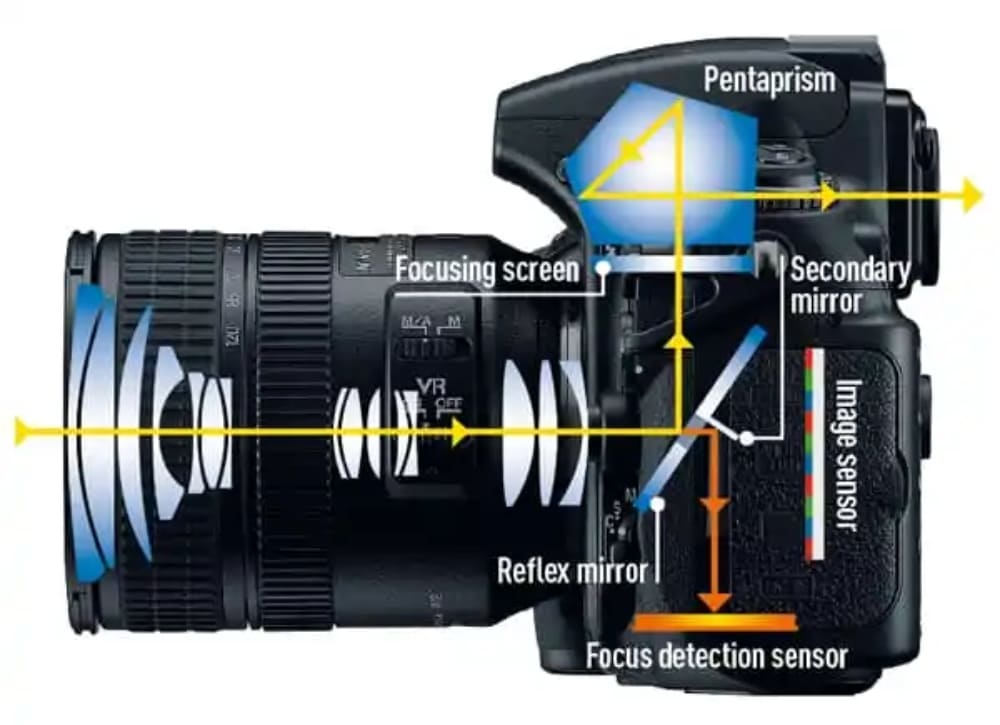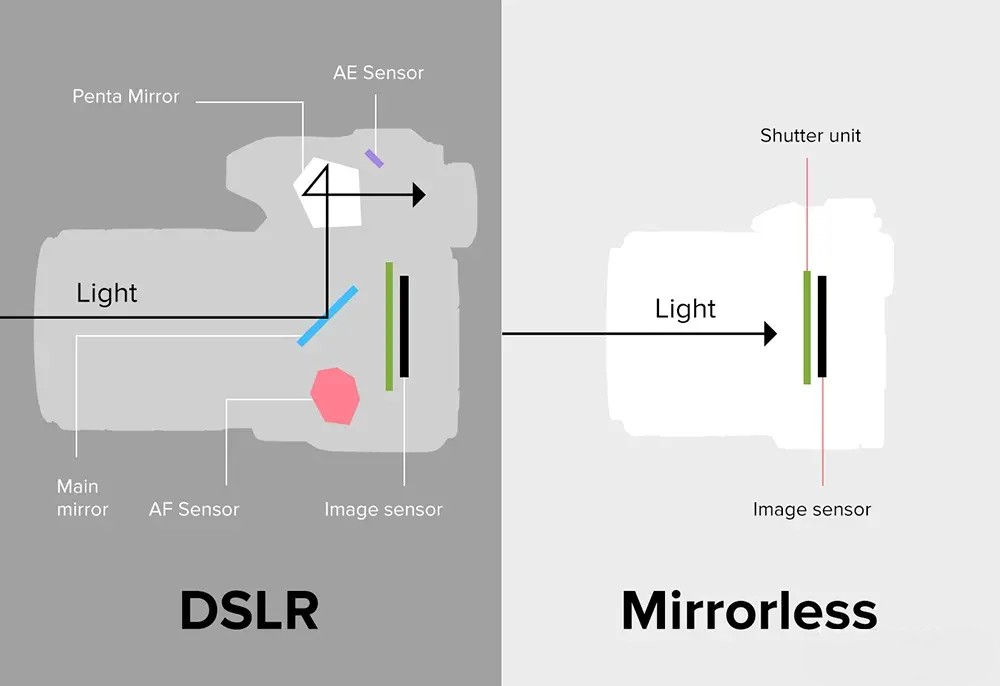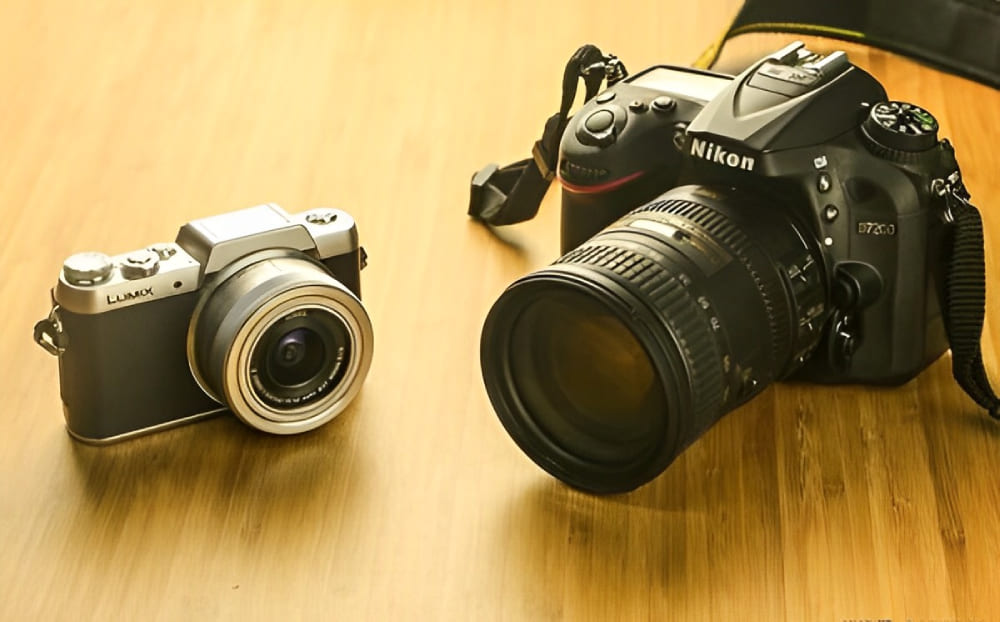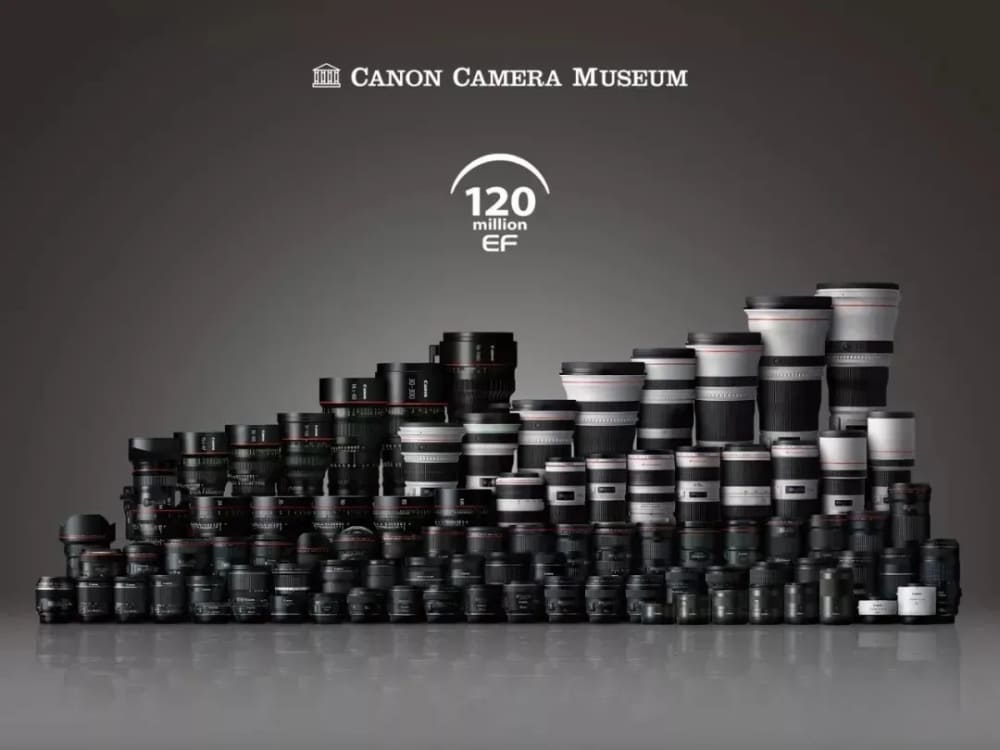Mirrorless vs DSLR Cameras: Which Is Best for You?
In the rapidly evolving world of digital photography, the choice between DSLR and mirrorless cameras has become a perennial dilemma for many photographers.
With both options offering their unique strengths and capabilities, it's essential to understand the differences between them to make an informed decision.
In this article, we'll embark on a journey to demystify the mirrorless vs DSLR debate. We'll delve into the key distinctions between these two camera types, exploring their features, advantages, and limitations in layman's terms.
Whether you're a beginner seeking your first camera or a seasoned photographer considering an upgrade, our goal is to equip you with the knowledge needed to navigate this complex decision-making process confidently.

In this article, you will learn:
- DSLR VS Mirrorless: What Are the Differences?
- DSLR VS Mirrorless: Which Is Best?
- DSLR VS Mirrorless: Which Has a Brighter Future?
- How Should You Choose a Camera to Buy?
DSLR VS Mirrorless: What Are the Differences
Before delving into the differences between DSLR and mirrorless cameras, let's first understand what each of them represents.
1. What Is a DSLR Camera
A DSLR, or Digital Single-Lens Reflex camera, refers to a camera that incorporates a reflex mirror and a pentaprism. When composing an image, light passes through the lens and is reflected by the mirror and pentaprism, allowing photographers to view the scene through the viewfinder.
The "reflex" in DSLR signifies its reliance on optical viewing, which means that even without power or batteries, one can still see the image through the viewfinder.
It's important to note that the term "DSLR" simply denotes the use of a single lens and a reflex viewfinder, without any specific requirements for image quality or performance. Therefore, strictly speaking, "DSLR" does not necessarily equate to "professional."
In other words, when faced with a DSLR camera, one should not automatically assume that it possesses superior image quality and performance. It's crucial to consider the actual specifications and features of the camera.
Furthermore, the optical viewfinder system used in DSLRs is not considered cutting-edge technology.
The world's first mass-produced camera with a reflex viewfinder can be traced back to the Monocular Duplex by C.R. Smith in 1884, which was a large format DSLR. The first 35mm (equivalent to today's full-frame) DSLR camera available on the market was the Ihagee Kine Exakta in 1936.
In other words, the reflex viewfinder system in DSLRs has been in use for over a century.
(To learn more about DSLR cameras, check out this article: What is a DSLR Camera: A Beginner's Guide)

2. What Is a Mirrorless Camera?
Mirrorless cameras, as the name suggests, do not have any mirrors inside. Instead, they utilize electronic viewfinders or LCD screens for composition. When light passes through the lens, it directly projects onto the image sensor without any reflections.
Photographers rely on the display screen or electronic viewfinder (essentially a screen) to observe the image, similar to how we use our smartphones.
(To learn more about DSLR cameras, check out this article: What is a Mirrorless Camera? A Beginner's Guide)
3. DSLR VS Mirrorless
Once we understand what DSLR and mirrorless cameras are, the differences between the two become quite apparent.
Fundamentally, the disparity lies in their respective viewfinder systems.
A DSLR is an interchangeable lens camera that utilizes an optical viewfinder system. It consists of a reflex mirror and a pentaprism inside the camera body. On the other hand, a mirrorless camera employs an electronic viewfinder system, with no reflex mirror or pentaprism.
The internal structure of the two can be compared as follows:

Due to the limitations of the traditional optical viewfinder system, which does not support video recording, DSLRs were later adapted by incorporating the ability to lift the reflex mirror for electronic viewfinding.
Currently, all DSLRs available in the market offer both optical and electronic viewfinder options. When using the electronic viewfinder, the imaging principle and viewing experience of DSLRs are identical to mirrorless cameras.
If you want to determine whether your camera is a DSLR or mirrorless, the simplest way is to remove the lens and check for the presence of a reflex mirror. However, it's important to exercise caution to prevent dust or debris from entering the camera and avoid touching any sensitive parts.
To reiterate key points:
- Both mirrorless and DSLR cameras are interchangeable lens systems. Therefore, any camera that does not support lens interchangeability, such as the Leica Q series, Ricoh GR series, Sony RX series, or Fuji X100 series, is not considered mirrorless or DSLR.
- Mirrorless and DSLR cameras are two distinct categories based on their viewfinder systems, existing as parallel options. Cameras with a reflex mirror are DSLRs, while those without a reflex mirror are mirrorless. There is no such thing as a camera that is both a DSLR and mirrorless.
- The size of a camera does not determine whether it is mirrorless or DSLR. Any interchangeable lens camera that utilizes an electronic viewfinder is considered mirrorless, regardless of its size or price.
- The term "DSLR" does not inherently imply professional-grade equipment, as any interchangeable lens camera with a reflex viewfinder is classified as a DSLR, regardless of its image quality or features.
Let's see the experience of shooting with a DSLR vs Mirrorless by Omar Gonzalez Photography.
DSLR VS Mirrorless: Which Is Best?
Let's compare DSLRs and mirrorless cameras from a few perspectives. However, since there are numerous models of both DSLRs and mirrorless cameras, each with their own unique features, this discussion will focus on the most mainstream and common scenarios, and some exceptional cases may not be included.
1. Image Quality, Complexity, and Professionalism: Completely Unrelated
As previously explained, the difference between DSLRs and mirrorless cameras lies in their viewfinder systems, with DSLRs utilizing an optical viewfinder and mirrorless cameras using an electronic viewfinder.
However, this difference in viewfinder structure merely affects how photographers observe the scene and does not impact the final image quality.
When the shutter is pressed, both DSLRs and mirrorless cameras capture light in the same way on their image sensors. Therefore, the notion that "mirrorless cameras have inferior image quality compared to DSLRs" is easily debunked.
Claims such as "mirrorless cameras are not professional" or "DSLRs are more complex" are baseless. Both the DSLR and mirrorless camps offer professional and amateur products, and they can both be operated with varying levels of complexity.
While we can compare the differences between specific models, it is not appropriate to make such sweeping generalizations about an entire category.
Furthermore, it is important not to assume that mirrorless cameras are cheaper. In reality, there is no significant price difference between mirrorless cameras and DSLRs.
While some mirrorless cameras from the same brand and at a similar level may be slightly cheaper than their DSLR counterparts (such as Canon 5D4 and R, 6D2 and RP), there are also many mirrorless models that are quite expensive.
2. Size, Weight, and Portability: Mirrorless Has the Advantage
While it was mentioned earlier that mirrorless cameras are not necessarily compact, they generally tend to be lighter, smaller, and more portable compared to DSLRs. This is because mirrorless cameras do not require components like reflex mirrors and pentaprisms.
It is important to reiterate that the reduction in size and weight of mirrorless cameras is achieved through a different viewfinder system. This reduction in size and weight does not imply inferior image quality or lack of professionalism. The quality of a camera is not inherently determined by its size and weight.

3. Battery Life: DSLRs Have an Advantage in Optical Viewfinder Mode
DSLRs, with their optical viewfinder system, do not require power to display the image in the viewfinder. Therefore, theoretically, DSLRs should be more power-efficient and have longer battery life compared to mirrorless cameras. However, in practice, this is not an absolute rule.
On one hand, camera manufacturers are well aware of the power consumption issue in mirrorless cameras and have been increasing battery capacity and optimizing battery life. In recent years, new mirrorless camera models have shown significant improvements in battery life, narrowing the gap with DSLRs.
On the other hand, as mentioned earlier, digital DSLRs available in the market now also support an "electronic viewfinder" mode. Strictly speaking, DSLRs are more power-efficient only when shooting with the optical viewfinder. In the electronic viewfinder mode, DSLRs consume similar power to mirrorless cameras, whether for still photography or video recording.
4. Viewfinder Experience: DSLRs Offer More Options, Mirrorless Cameras Are More User-Friendly
DSLRs available in the market now offer both optical and electronic viewfinders, while mirrorless cameras only have electronic viewfinders. This means that DSLRs provide a wider range of options.
When comparing optical and electronic viewfinders, we find that optical viewfinders offer a better visual experience, while electronic viewfinders are more suitable for beginners.
The optical viewfinder of a DSLR provides a natural and authentic viewing experience because the entire process is based on optical refraction and reflection. The image seen through the viewfinder is akin to looking at a scene through a window.
Regardless of how a photographer adjusts parameters such as color temperature, ISO, and shutter speed, the image in the optical viewfinder remains unchanged. If a photographer is not well-versed in the effects of these settings, they will need to review the captured photos to assess the results, which can be somewhat inconvenient.
On the other hand, the electronic viewfinder of a mirrorless camera displays the image on a screen. Although the viewing experience may not be as comfortable as with an optical viewfinder, when adjusting parameters, photographers can observe the real-time effects on the image and clearly see how different settings impact the picture.
In summary, the image seen through a DSLR's viewfinder closely resembles what the naked eye sees, while the image seen through a mirrorless camera's viewfinder closely resembles the final captured image.

5. Video Capabilities: Mirrorless Cameras Are More Suitable
As mentioned earlier, the viewing mechanism does not determine the image quality, so don't expect mirrorless cameras to produce better video quality than DSLRs.
However, since DSLRs were invented over a hundred years ago, the concept of shooting videos was not considered at that time. As a result, their optical viewfinder structure does not support video recording. Modern digital DSLRs require lifting the reflex mirror and adopting an "electronic viewfinder" approach to shoot videos.
This significantly diminishes the advantage of DSLRs in terms of battery life and doesn't change their disadvantage in terms of size and weight.
Given these factors, why not directly choose a mirrorless camera for shooting videos?
6. Camera Lens Variety: DSLRs Have the Advantage
The lens variety refers to the total number of lenses available for a camera system. Due to their longer development history, DSLRs undoubtedly offer a greater selection of lenses. For example, Canon's full-frame DSLRs with EF mount and Nikon's full-frame DSLRs with F mount have over two hundred lens options each.
On the other hand, mirrorless cameras have varying lens options due to the different brands' development timelines and levels of commitment to the mirrorless market.
The most comprehensive lens systems for mirrorless cameras are Sony's E-mount system and the M43 system led by Panasonic and Olympus (now known as OM Digital Solutions), both offering over a hundred lens choices.
Currently, the lens options for Canon's full-frame mirrorless cameras with RF mount and Nikon's mirrorless cameras with Z mount are relatively limited, with fewer than 50 native mount lenses available.
However, over time, the lens selection for mirrorless cameras is expected to improve. Moreover, if there are no suitable lens options available, mirrorless camera users can utilize adapters to use DSLR lenses as a compromise solution.

DSLR VS Mirrorless: Which Has a Brighter Future?
There is no doubt that mirrorless cameras will be the primary form of cameras in the future, while DSLRs will gradually become niche products.
From a theoretical standpoint, mirrorless cameras have electronically replaced certain mechanical components found in DSLRs, making them more advanced and promising in terms of technology.
If you need real-world evidence, camera manufacturers are progressively discontinuing their DSLR lines. Fuji's last DSLR release was in 2007 (FinePix IS Pro), Panasonic in 2008 (L10), Olympus in 2010 (E5), and Sony also in 2010 (A580).
Currently, only Canon, Nikon, and Ricoh (Pentax) continue to maintain their DSLR business, but even Canon and Nikon's DSLR divisions have become practically obsolete. From 2021 to 2022, Ricoh was the only company to release two new Pentax DSLRs, indicating a decreasing trend in DSLR releases.
Therefore, whether considering it from a theoretical perspective or based on actual data, mirrorless cameras are the future of photography. However, DSLRs will not completely disappear, as there are still many photography enthusiasts who enjoy shooting with film cameras.
How Should You Choose a Camera to Buy?
As we have emphasized repeatedly, since the viewing mechanism does not have a decisive impact on image quality and visual effects, it's better to focus on other functional aspects of the camera model.
Choosing a camera that best fits your budget and personal needs is the key. There's no need to insist on buying only a mirrorless or a DSLR camera.
However, with the increasing number of excellent mirrorless products occupying various price ranges and the discontinuation of various DSLR series, in general, we recommend giving priority to considering mirrorless cameras.
Here are a few additional points we suggest:
1. For first-time camera buyers, we highly recommend mirrorless cameras.
For beginners, we suggest starting with a mirrorless camera as their first camera. The reasons for this include its high portability, intuitive viewing mechanism, and easier future upgrades.
If you insist on purchasing a DSLR now, you may find yourself switching back to the mirrorless camp when it's time to upgrade in a few years, requiring you to readjust and learn all over again. It's best to avoid this unnecessary hassle.
2. For those primarily interested in shooting videos, mirrorless cameras are more suitable.
As mentioned above, mirrorless cameras are better suited for video recording, while using a DSLR would only burden the shooter with unnecessary bulk and weight. Don't underestimate the size and weight of the camera, as a larger and heavier camera also means larger, heavier, and more expensive accessories.
3. For professionals with specific lens requirements, research lens options for mirrorless cameras.
As previously mentioned, there are noticeable differences in the lens selections available for various mirrorless camera brands.
Some brands offer over a hundred lens options, while others have only around thirty. If you have special lens needs, requiring specific focal lengths or apertures (such as for sports, wildlife, or astrophotography), it's best to research which brands can meet those requirements beforehand.
4. In photographic post-processing, consider using TourBox to enhance your workflow efficiency.
TourBox is a compact and ergonomic controller designed to provide intuitive and customizable controls for commonly used editing software and applications.

By connecting TourBox to your computer, you can assign specific functions and shortcuts to its buttons, dials, and knobs, tailored to your editing preferences. This allows for a more streamlined and efficient editing experience.
With TourBox, you'll have quick and precise control over adjustments such as exposure, contrast, saturation, and other editing tools right at your fingertips. It reduces the reliance on keyboard shortcuts and mouse movements, freeing you to focus more on the creative aspects of your work.
In conclusion, the ongoing debate of mirrorless vs DSLR cameras has sparked considerable discussions among photography enthusiasts. Both camera types have their strengths and weaknesses, offering unique features that cater to different needs.
The choice between mirrorless and DSLR cameras boils down to personal preferences, shooting style, and specific requirements. Both camera systems have their merits, and the decision should be based on individual needs, budgets, and long-term goals.
It's not a matter of declaring one format superior to the other but rather understanding that DSLR vs mirrorless is a matter of choice, with each offering its own unique advantages and capabilities.
It's an exciting time to be part of the photography world, as both camera types continue to push boundaries and inspire photographers to capture the world through their lenses.